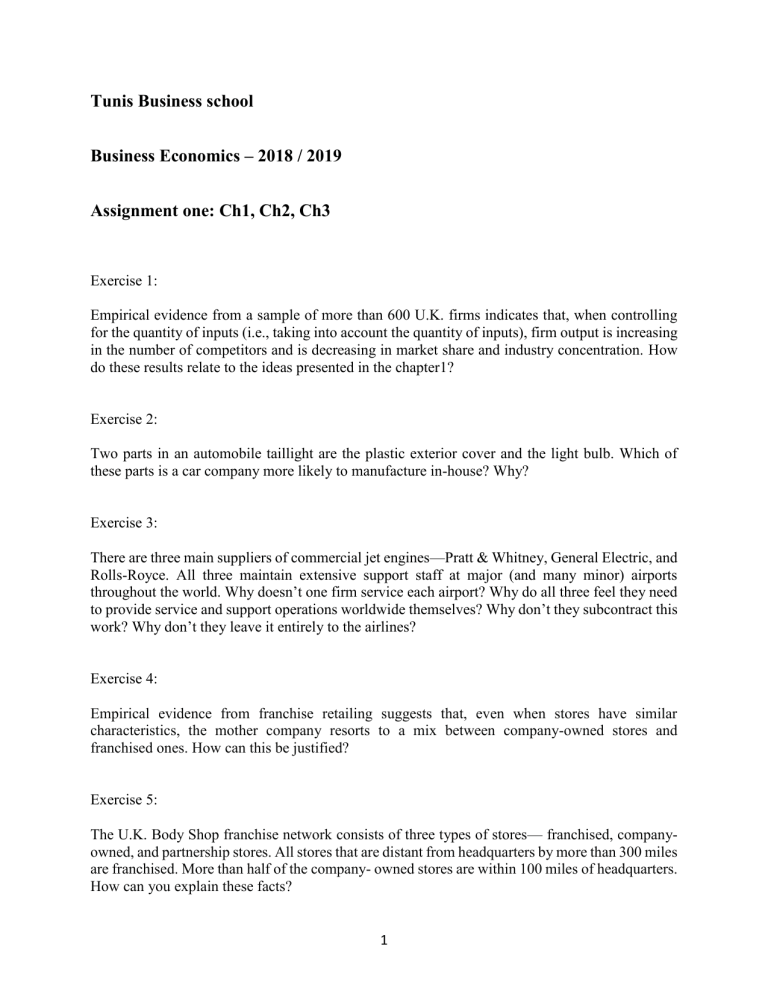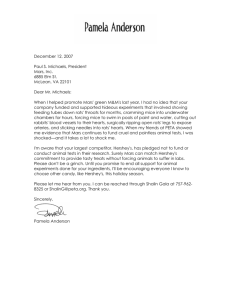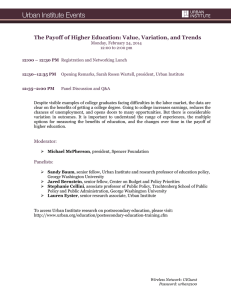
Tunis Business school Business Economics – 2018 / 2019 Assignment one: Ch1, Ch2, Ch3 Exercise 1: Empirical evidence from a sample of more than 600 U.K. firms indicates that, when controlling for the quantity of inputs (i.e., taking into account the quantity of inputs), firm output is increasing in the number of competitors and is decreasing in market share and industry concentration. How do these results relate to the ideas presented in the chapter1? Exercise 2: Two parts in an automobile taillight are the plastic exterior cover and the light bulb. Which of these parts is a car company more likely to manufacture in-house? Why? Exercise 3: There are three main suppliers of commercial jet engines—Pratt & Whitney, General Electric, and Rolls-Royce. All three maintain extensive support staff at major (and many minor) airports throughout the world. Why doesn’t one firm service each airport? Why do all three feel they need to provide service and support operations worldwide themselves? Why don’t they subcontract this work? Why don’t they leave it entirely to the airlines? Exercise 4: Empirical evidence from franchise retailing suggests that, even when stores have similar characteristics, the mother company resorts to a mix between company-owned stores and franchised ones. How can this be justified? Exercise 5: The U.K. Body Shop franchise network consists of three types of stores— franchised, companyowned, and partnership stores. All stores that are distant from headquarters by more than 300 miles are franchised. More than half of the company- owned stores are within 100 miles of headquarters. How can you explain these facts? 1 Exercise 6: Suppose that a firm’s profits are given by π = α + φ(e) + ε, where α denotes the intensity of product market competition, e effort by the manager, and ε a random shock. The function φ(e) is increasing and concave, that is, φ′ > 0 and φ′′ < 0. For the firm to survive, it must be that profits are greater than π. The manager’s payoff is β > 0 if the firm survives and zero if it is liquidated, that is, if profits fall short of the minimum target. The idea is that if the firm is liquidated, then the manager loses his job and the rents associated with it. Suppose that ε is normally distributed with mean μ and variance σ 2, and that μ > π . Show that increased product market competition (lower α) induces greater effort by the manager, that is, ∂ e/∂α < 0. The manager’s payoff is given by this equation: P = β P (α + φ(e) + ε > π ) - e Exercise 7: Figure A represents a series of two-player games that illustrate the rivalry between Time magazine and Newsweek. Each magazine’s strategy consists of choosing a cover story: “Impeachment” and “Financial Crisis” are the two choices. In each cell, the first number is the payoff for the row player (Time). The first version of the game corresponds to the case when the game is symmetric (Time and Newsweek are equally well positioned). As the payoff matrix suggests, “Impeachment” is a better story but payoffs are lower when both magazines choose the same story. The second version of the game corresponds to the assumption that Time is a more popular magazine (Time’s payoff is greater than Newsweek’s when both magazines cover the same story). Finally, the third version of the game illustrates the case in which the magazines are sufficiently different that some readers will buy both magazines even if they cover the same story. 2 Figure A The Cover-Story Game. For each of the three versions of the game, a. Determine whether the game can be solved by dominant strategies. b. Determine all Nash equilibria. c. Indicate clearly which assumptions regarding rationality are required in order to reach the solutions in (a) and (b). Exercise 8: Hernan Cortez, the Spanish navigator and explorer, is said to have burnt his ships upon arrival to Mexico. By so doing, he effectively eliminated the option of him and his soldiers returning to their homeland. Discuss the strategic value of this action, knowing the Spanish colonists were faced with potential resistance from the Mexican natives (draw the game tree). 3 Exercise 9: Consider the following game Figure B depicting the process of standard setting in high- definition television (HDTV). The United States and Japan must simultaneously decide whether to invest a high or a low value into HDTV research. Each country’s payoffs are summarized. 1. Are there any dominant strategies in this game? What is the Nash equilibrium of the game? What are the rationality assumptions implicit in this equilibrium? 2. Suppose now that the United States has the option of committing to a strategy before Japan’s decision is reached. How would you model this new situation? What are the Nash equilibria of this new game? (draw the game tree) 3. Comparingtheanswersto(a)and(b),whatcanyousayaboutthevalueofcommitment for the United States? Figure B: The HDTV Game: Each Country Chooses a High or a Low Level of R&D on HDTV. Exercise 10: Consider a one-shot game with two equilibria and suppose that this game is repeated twice. Explain in words why there may be equilibria in the two-period game that are different from the equilibria of the one-shot game. Exercise 11 Draw the extensive form for the following game (invent your own payoff vectors, because there is no payoff information). There is an industry in which two firms compete as follows: First, firm 1 decides whether to set a high price (H) or a low price (L). After seeing firm 1’s price, firm 2 decides whether to set a high price (H) or a low price (L). If both firms selected the low price, then the game ends with no further interaction. If either or both firms selected the high price, then the attorney general decides whether to prosecute (P) or not (N) for anticompetitive behavior. In this case, the attorney general does not observe which firm selected the high price (or if both firms selected the high price). 4 Exercise 12: In the movie E.T., a trail of Reese’s Pieces, one of Hershey’s chocolate brands, is used to lure the little alien out of the woods. As a result of the publicity created by this scene, sales of Reese’s Pieces trebled, allowing Hershey to catch up with rival Mars. Universal Studio’s original plan was to use a trail of Mars’ M&Ms. However, Mars turned down the offer, presumably because it thought $1 million, the price demanded by the producer of E.T., was very high. The makers of E.T. then turned to Hershey, who accepted the deal. Suppose that the publicity generated by having M&Ms included in the movie would increase Mars’ profits by $800,000. Suppose moreover that Hershey’s increase in market share cost Mars a loss of $500,000. Finally, let b be the benefit for Hershey from having its brand be the chosen one. Describe the preceding events as a game in extensive form. Determine the equilibrium as a function of b. If the equilibrium differs from the actual events, how do you think they can be reconciled? (draw the game tree) . 5



